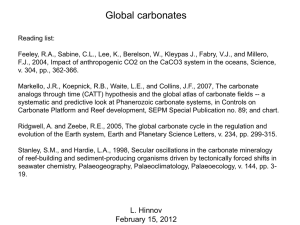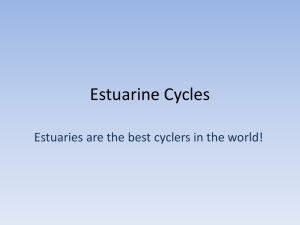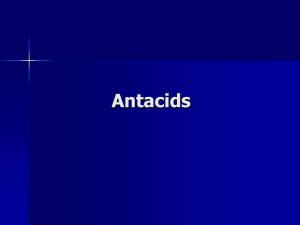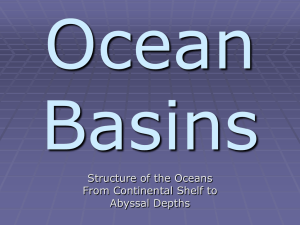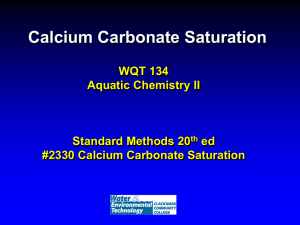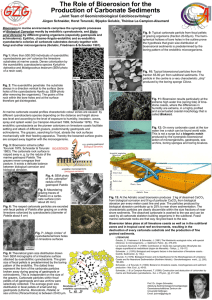shallow marine carbonate environments
advertisement
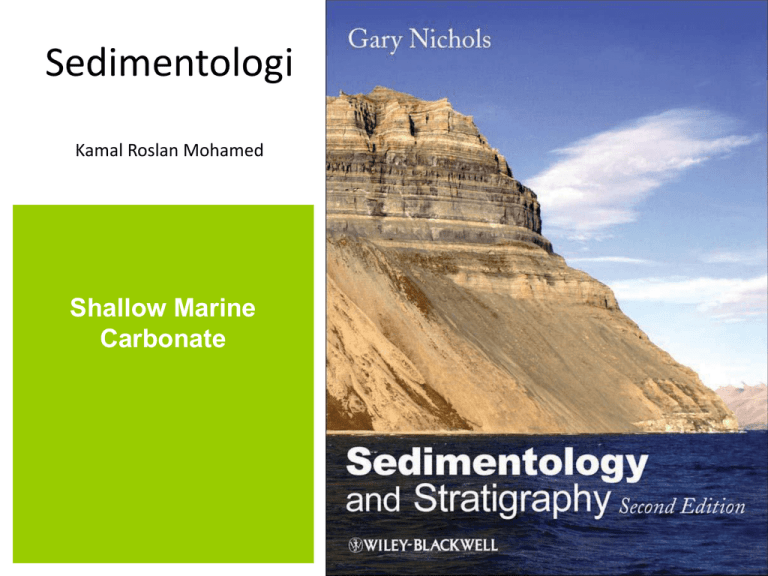
Sedimentologi Kamal Roslan Mohamed Shallow Marine Carbonate INTRODUCTION Limestones are common and widespread sedimentary rocks that are mainly formed in shallow marine depositional environments. Most of the calcium carbonate that makes up limestone comes from biological sources, ranging from the hard, shelly parts of invertebrates such as molluscs to very fine particles of calcite and aragonite formed by algae. The accumulation of sediment in carbonate-forming environments is largely controlled by factors that influence the types and abundances of organisms that live in them. Water depth, temperature, salinity, nutrient availability and the supply of terrigenous clastic material all influence carbonate deposition and the build up of successions of limestones. INTRODUCTION Some depositional environments are created by organisms, for example, reefs built up by sedentary colonial organisms such as corals. Changes in biota through geological time have also played an important role in determining the characteristics of shallow-marine sediments through the stratigraphic record. In arid settings carbonate sedimentation may be associated with evaporite successions formed by the chemical precipitation of gypsum, anhydrite and halite from the evaporation of seawater. Shallow marine environments can be sites for the formation of exceptionally thick evaporite successions, so-called ‘saline giants’, that have no modern equivalents. CARBONATE DEPOSITIONAL ENVIRONMENTS There are a number of features of shallow marine carbonate environments that are distinctive when compared with the terrigenous clastic epositional settings; • they are largely composed of sedimentary material that has formed in situ (in place), mainly by biological processes. • the grain size of the material deposited is largely determined by the biological processes that generate the material, not by the strength of wave or current action, although these processes may result in breakup of clasts during reworking. • the biological processes can determine the characteristics of the environment, principally in places where reef formation strongly controls the distribution of energy regimes. • the production of carbonate material by organisms is rapid in geological terms, and occurs at rates that can commonly keep pace with changes in water depth due to tectonic subsidence or eustatic sea-level rises: this has important consequences for the formation of depositional sequences Controls on carbonate sedimentation Isolation from clastic supply The primary requirement for the formation of carbonate platforms is an environment where the supply of terrigenous clastic and volcaniclastic detritus is very low and where there is a supply of calcium carbonate. Along coastlines distant from these deltas the clastic supply is generally low, with only relatively small river systems providing detritus. This allows for quite extensive stretches of continent to be areas that receive little or no terrigenous sandy or muddy sediment. Controls on carbonate sedimentation Shallow marine waters The amount of biogenic carbonate produced in shallow seas is determined by the productivity within the food chain. Photosynthetic plants and algae at the bottom of the food chain are dependent on the availability of light, and penetration by sunlight is controlled by the water depth and the amount of suspended material in the sea. Controls on carbonate sedimentation Shallow marine waters Relatively shallow waters with low amounts of suspended terrigenous clastic material are therefore most favourable and in bright tropical regions with clear waters this photic zone may extend up to 100m water depth. This shallow region of high biogenic productivity is referred to as the carbonate factory. Morphologies of shallow marine carbonate-forming environments The term ‘carbonate platform / platform karbonat’ can be generally applied to any shallow marine environment where there is an accumulation of carbonate sediment. If the platform is attached to a continental landmass it is called a carbonate shelf / pelantar karbonat, a region of sedimentation that is analogous to shelf environments for terrigenous clastic deposition. Morphologies of shallow marine carbonate-forming environments Carbonate banks / timbunan karbonat are isolated platforms that are completely surrounded by deep water and therefore do not receive any terrigenous clastic supply. A carbonate atoll is a particular class of carbonate bank formed above a subsiding volcanic island. Morphologies of shallow marine carbonate-forming environments Three morphologies of carbonate platform are recognised: they may be flat-topped with a sharp change in slope at the edge forming a steep margin, either as a rimmed (berbingkai) or non-rimmed shelf, or they may have a ramp / tanjakan morphology, a gentle (typically less than 1°) slope down to deeper water with no break in slope. Morphologies of shallow marine carbonate-forming environments Three morphologies of carbonate platform are recognised: they may be flat-topped with a sharp change in slope at the edge forming a steep margin, either as a rimmed (berbingkai) or non-rimmed shelf, or they may have a ramp / tanjakan morphology, a gentle (typically less than 1°) slope down to deeper water with no break in slope. Carbonate grain types and assemblages The relative abundance of the different carbonate-forming organisms has varied considerably though time. the characteristics of shallow marine carbonate facies depend on the time period in which they were deposited. Most significantly, the absence of abundant shelly organisms in the Precambrian means that carbonate facies from this time are markedly different from Phanerozoic deposits in that they lack bioclastic components. Carbonate grain types and assemblages The skeletal grain associations that occur on carbonate platforms are temperature / suhu and salinity / kemasinan dependent. In low latitudes where the shallow sea is always over 15°C and the salinity is normal, corals and calcareous green algae are common and along with numerous other organisms form a chlorozoan assemblage. In restricted seas where the salinities are higher only green algae flourish, and form a chloralgal association. Temperate carbonates formed in cooler waters are dominated by the remains of benthic foraminifers and molluscs, a foramol assemblage. Ooids are most commonly associated with chlorozoan and chloralgal assemblages. COASTAL CARBONATE AND EVAPORITE ENVIRONMENTS Beaches The patterns of sedimentation along high-energy coastlines with carbonate sedimentation are very similar to those of clastic, wave-dominated coastlines. Carbonate material in the form of bioclastic debris and ooids is reworked by wave action into ridges that form strand plains along the coast or barrier islands separated from the shore by a lagoon. The texture of carbonate sediments deposited on barrier island and strand plain beaches is typically well-sorted and with a low mud matrix content (grainstone and packstone). Few organisms live in the high-energy foreshore zone, so almost all of the carbonate detritus is reworked from the shoreface. COASTAL CARBONATE AND EVAPORITE ENVIRONMENTS Beach barrier lagoons Lagoons form along carbonate coastlines where a beach barrier wholly or partly encloses an area of shallow water. The character of the lagoon deposits depends on the salinity of the water and this in turn is determined by two factors: the degree of connection with the open ocean and the aridity of the climate. Carbonate lagoons Carbonate lagoons are sites of fine-grained sedimentation forming layers of carbonate mudstone and wackestone with some grainstone and packstone beds deposited as washovers near the beach barrier. The nature of the carbonate material deposited on ebb- and flood-tidal deltas depends on the type of material being generated in the shallow marine waters: it may be bioclastic debris or oolitic sediment forming beds of grainstone and packstone Carbonate lagoons The source of the fine-grained carbonate sediment in lagoons is largely calcareous algae living in the lagoon, with coarser bioclastic detritus from molluscs. Pellets formed by molluscs and crustaceans are abundant in lagoon sediments. The nature and diversity of the plant and animal communities in a carbonate lagoon is determined by the salinity. Arid lagoons In hot, dry climates the loss of water by evaporation from the surface of a lagoon is high. If it is not balanced by influx of fresh water from the land or exchange of water with the ocean the salinity of the lagoon will rise and it will become hypersaline, more concentrated in salts than normal seawater. An area of hypersaline shallow water that precipitates evaporite minerals is known as a saltern. Deposits are typically layered gypsum and/ or halite occurring in units metres to tens of metres thick. A carbonate-dominated coast with a barrier island in an arid climatic setting: evaporation in the protected lagoon results in increased salinity and the precipitation of evaporite minerals in the lagoon. Supratidal carbonates and evaporites Supratidal carbonate flats The supratidal zone lies above the mean high water mark and is only inundated by seawater under exceptional circumstances, such as very high tides and storm conditions. Where the gradient to the shoreline is very low the supratidal zone is a marshy area where microbial (algal and bacterial) mats form. In arid coastal settings a sabkha environment may develop. Evaporation in the supratidal zone results in saline water being drawn up through the coastal sediments and the precipitation of evaporite minerals within and on the sediment surface. Arid sabkha flats Arid shorelines are found today in places such asthe Arabian Gulf, where they are sites of evaporite formation within the coastal sediments. These arid coasts are called sabkhas. Gypsum and anhydrite grow within the sediment while a crust of halite forms at the surface. In arid coastal settings a sabkha environment may develop. Evaporation in the supratidal zone results in saline water being drawn up through the coastal sediments and the precipitation of evaporite minerals within and on the sediment surface. Intertidal carbonate deposits In the intertidal zones deposits of lime mud and shelly mud are subject to subaerial desiccation at low tide. Terrigenous clastic mud remains relatively wet when exposed between tidal cycles, but carbonate mud inwarmclimates tends to dry out and form a crust by syndepositional cementation. Tide-influenced coastal carbonate environments. SHALLOW MARINE CARBONATE ENVIRONMENTS The character of deposits in shallow marine carbonate environments is determined by the types of organisms present and the energy from waves and tidal currents. The sources of the carbonate material are predominantly biogenic, including mud from algae and bacteria, sand-sized bioclasts, ooids and peloids and gravelly debris that is skeletal or formed from intraclasts.Bioturbation is usually very common and faecal pellets contribute to the sediment. A number of different carbonate deposits are characteristic of many shallow marine environments, for example shoals of sand-sized material, reefs and mud mounds. Carbonate sand shoals / beting pasir karbonat Sediment composed of sand to granule-sized, loose carbonate material occurs in shallow, high energy areas. These carbonate shoals may be made up of ooids, mixtures of broken shelly debris or may be accumulations of benthic foraminifers. Reworking by wave and tidal currents results in deposits made up of wellsorted, well-rounded material: when lithified these form beds of grainstone, or sometimes packstone. Sedimentary structures may be similar to those found in sand bodies on clastic shelves, including planar and trough cross-bedding generated by the migration of subaqueous dune bedforms. However, the degree of reworking is often limited by early carbonate cementation. Extensive wave action tends to build up shoals that form banks parallel to the coastline, whereas tidal currents in coastal regions result in bodies Reefs / Terumbu Modern corals in a fringing reef. The hard parts of the coral and other organisms form a boundstone deposit. Reefs are carbonate bodies built up mainly by framework- building benthic organisms such as corals. They are waveresistant structures that form in shallow waters on carbonate platforms. The term ‘reef’ is used by mariners to indicate shallow rocky areas at sea, but in geological terms they are exclusively biological features. Reef build-ups are sometimes referred to as bioherms: carbonate build-ups that do not form domeshaped reefs but are instead tabular forms known as biostromes. Modern coral atolls. Reef-forming organisms Scleractinian corals are the main reef builders in modern oceans, as they have been for much of the Mesozoic and Cenozoic. These corals are successful because many of the taxa are hermatypic, that is, they have a symbiotic relationship with algae, which allows the corals to grow rapidly in relatively nutrient-poor water. The other main modern reefs builders are calcareous algae. Reef-forming organisms However, over the past 2500 Myr a number of different types of organisms have performed this role. The earliest reef-builders were cyanobacteria, which created stromatolites, followed in the Palaeozoic by rugose and tabulate corals and calcareous sponges (including stromatoporoids), which were particularly important in the Devonian. The most unusual reef-forming organism was a type of bivalve, the rudists: the shells of these molluscs were thick and conical, forming massive colonies, which are characteristic of many Cretaceous reefs. Reef structures Modern reefs can be divided into a number of distinct subenvironments. The reef crest is the site of growth of the corals that build the most robust structures, encrusting and massive forms capable of withstanding the force of waves in very shallow water. Reef structures Going down the reef front these massive and encrusting forms of coral are replaced by branching and more delicate plate-like forms in the lower energy, deeper water. Behind the reef crest is a reef flat, also comprising relatively robust forms, but conditions become quieter close to the back-reef area and globular coral forms are common in this region. Reef structures Break-up of the reef core material by wave and storm action leads to the formation of a talus slope of reefal debris. This forereef setting is a region of accumulation of carbonate breccia to form bioclastic rudstone and grainstone facies. Reef structures Behind the reef crest the back reef is sheltered from the highest energy conditions and is the site of deposition of debris removed from the reef core and washed towards the lagoon. A gradation from rudstone to grainstone deposits of broken reef material, shells and occasionally ooids forms a fringe along the margin of the lagoon. Reef settings Three main forms of reef have been recognised in modern oceans. Fringing reefs are built out directly from the shoreline and lack an extensive back-reef lagoonal area. fringing reefs build at the coastline Reef settings Barrier reefs, of which the Great Barrier Reef of eastern Australia is a distinctive example, are linear reef forms that parallel the shoreline, but lie at a distance of kilometres to tens of kilometres offshore: they create a back-reef lagoon area which is a large area of shallow, low-energy sea, which is itself an important ecosystem and depositional setting. barrier reefs form offshore on the shelf and protect a lagoon behind them Reef settings Patch reefs: In open ocean areas coral atolls develop on localised areas of shallow water, such as seamounts, which are the submerged remains of volcanic islands. In addition to these settings of reef formation, evidence from the stratigraphic record indicates that there are many examples of patch reefs, localised build-ups in shallow water areas such as epicontinental seas, carbonate platforms and lagoons. patch reefs or atolls are found isolated offshore, for instance on a seamount Carbonate mud mounds A carbonate mud mound is a sediment body consisting of structureless or crudely bedded fine crystalline carbonate. Modern examples of carbonate mud mounds are rare. Many mounds are made of the remains of microbes that had calcareous structures and these microbes grew in place to build up the body of sediment. Others have a large component of detrital material, again mainly the remains of algae and bacteria, which have been piled up into a mound of loose material. It is also possible that some skeletal organisms such as calcareous sponges and bryozoans are responsible for building carbonate mud mounds. Outer shelf and ramp carbonates On the outer parts of shelves carbonate sedimentation is dominated by fine-grained deposits. These carbonate mudstones are composed of the calcareous remains of planktonic algae and other fine grained biogenic carbonate. This facies is found in both modern and ancient outer platform settings and when lithified the fine-grained carbonate sediment is called chalk. Similar facies also occur in deeper water settings. Chalk deposited in shallower water may contain the shelly remains of benthic and planktonic organisms and there is extensive evidence of bioturbation in some units. Platform margins and slopes The edge of a carbonate platform may be marked by an abrupt change in slope or there may be a lower angle transition to deeper water facies. The front of a reef can form a vertical ‘wall’ and along with other slopes too steep for sediment accumulation are by-pass margins. Sediment accumulates at the base of the slope, brought in by processes ranging from large blocks fallen from the reef front to submarine talus slopes, slumps, debris flows and turbidites. Platform margins and slopes The most proximal material forms rudstone deposits, which are sometimes called mega breccias if they contain very large blocks, passing distally to redeposited packstones, to turbiditic wackestones and mudstones. Depositional margins form on more gentle slopes with a continuous spectrum of sediments from the reef boundstones or shoal grainstones of the shelf margin to packstones, wackestones and mudstones further down the slope. Finer grained sediments tend to be unstable on slopes and slumping of the mudstones and wackestones may occur, resulting in contorted, redeposited beds. TYPES OF CARBONATE PLATFORM A number of different morphologies of carbonate platform are recognised, the most widely documented being carbonate ramps, which are gently sloping platforms, and rimmed shelves, which are flat-topped platforms bordered by a rim formed by a reef or carbonate sand shoal. Carbonate ramps – Distribution of facies on a carbonate ramp The inner ramp is the shallow zone that is most affected by wave and/or tidal action. Coastal facies along tidally influenced shorelines are characterised by deposition of coarser material in channels and carbonate muds on tidal flats. Carbonate ramps – Distribution of facies on a carbonate ramp The mid-ramp area lies below fair-weather wave base and the extent of reworking by shallow-marine processes is reduced. Storm processes transport bioclastic debris out on to the shelf to form deposits of wackestone and packstone, which may include hummocky and swaley cross-stratification. Carbonate ramps – Distribution of facies on a carbonate ramp In deeper water below storm wave base the outer ramp deposits are principally redeposited carbonate mudstone and wackestone, often with the characteristics of turbidites. Redeposition of carbonate sediments is common in situations where the outer edge of the ramp merges into a steeper slope at a continental margin as a distally steepened ramp. Carbonate ramps – Carbonate ramp succession A succession built up by the progradation of a carbonate ramp is characterised by an overall coarsening up from carbonate mudstone and wackestone deposited in the outer ramp environment to wackestones and packstones of the mid-ramp to packstone and grainstone beds of the inner ramp. The degree of sorting typically increases upwards, reflecting the higher energy conditions in shallow water. Carbonate ramps – Carbonate ramp succession Inner ramp carbonate sand deposits are typically oolitic and bioclastic grainstone beds that exhibit decimetre to metre-scale crossbedding and horizontal stratification. The top of the succession may include finegrained tidal flat and lagoonal sediments. Ooids, broken shelly debris, algal material and benthic foraminifers may all be components of ramp carbonates. Locally mud mounds and patch reefs may occur within carbonate ramp successions. Non-rimmed carbonate shelves – Non-rimmed carbonate shelves are flat-topped shallow marine platforms that are more-or-less horizontal, in contrast to the gently dipping morphology of a carbonate ramp. They lack any barrier at the outer margin of the shelf and as a consequence the shallow waters are exposed to the full force of oceanic conditions. These are therefore highenergy environments where carbonate sediments are repeatedly reworked by wave action in the inner part of the shelf and where redeposition by storms affects the outer shelf area. Non-rimmed carbonate shelves – They therefore resemble storm-dominated clastic shelves, but the deposits are predominantly carbonate grains. Extensive reworking in shallow waters may result in grainstones and packstones, whereas wackestones and mudstones are likely to occur in the outer shelf area. Coastal facies are typically low energy tidalflat deposits but a beach barrier may develop if the wave energy is high enough. Rimmed carbonate shelves – Distribution of facies on a carbonate rimmed shelf A rimmed carbonate shelf is a flat-topped platform that has a rim of reefs or carbonate sand shoals along the seaward margin. In cases where the barrier is a reef, the edge of the shelf is made up of an association of reef-core, fore-reef and back-reef facies: the reef itself forms a bioherm hundreds of metres to kilometres across. Rimmed carbonate shelves – Distribution of facies on a carbonate rimmed shelf Sand shoals may be of similar extent where they form the shelf-rim barrier. Progradation of a barrier results in steepening of the slope at the edge of the shelf and the slope facies are dominated by redeposited material in the form of debris flows in the upper part and turbidites on the lower part of the slope. These pass laterally into pelagic deposits of the deep basin. Rimmed carbonate shelves – Distribution of facies on a carbonate rimmed shelf The back-reef facies near to the barrier may experience relatively high wave energy resulting in the formation of grainstones of carbonate sand and skeletal debris reworked from the reef. Further inshore the energy is lower and the deposits are mainly wackestones and mudstones. However, ooidal and peloidal complexes may also occur in the shelf lagoon and patch reefs can also form. Rimmed carbonate shelves – Distribution of facies on a carbonate rimmed shelf In inner shelf areas with very limited circulation and under conditions of raised salinities the fauna tends to be very restricted. In arid regions evaporite precipitation may become prominent in the shelf lagoon if the barrier provides an effective restriction to the circulation of seawater. Rimmed carbonate shelves – Rimmed carbonate shelf successions As deposition occurs on the rimmed shelf under conditions of static or slowly rising sea level the whole complex progrades. The reef core builds out over the fore reef and back-reef to lagoon facies overlie the reef bioherm. Distally the slope deposits of the fore reef prograde over deeper water facies comprising pelagic carbonate mud and calcareous turbidite deposits. Rimmed carbonate shelves – Rimmed carbonate shelf successions The association of reef-core boundstone facies overlying forereef rudstone deposits and overlain by finer grained sediments of the shelf lagoon forms a distinctive facies association. Rimmed carbonate shelves – Rimmed carbonate shelf successions Under conditions of sea-level fall the reef core may be subaerially exposed and develop karstic weathering, and a distinctive surface showing evidence of erosion and solution may be preserved in the stratigraphic succession if subsequent sealevel rise results in further carbonate deposition on top. Characteristics of shallow marine carbonates • lithology – limestone • mineralogy – calcite and aragonite • texture – variable, biogenic structures in reefs, well sorted in shallow water • bed geometry – massive reef build-ups on rimmed shelves and extensive sheet units on ramps • sedimentary structures – cross-bedding in oolite shoals • palaeocurrents – not usually diagnostic, with tide, wave and storm driven currents • fossils – usually abundant, shallow marine fauna most common • colour – usually pale white, cream or grey • facies associations – may occur with evaporites, associations with terrigenous clastic material may occur SEKIAN


